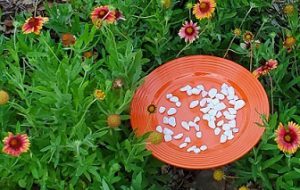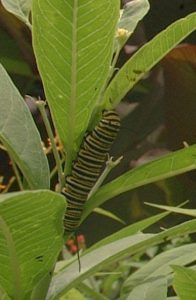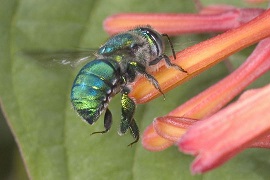
If you are anything like me, you might already have a few plants that provide for pollinators. Last year, when I started to renovate my landscape, I knew I wanted to plant various spaces to welcome pollinators and help them find food sources in the coming Florida spring. Those spaces are anchored by perennials and I just replenish the annuals when they are spent seasonally. One area has a firebush, Hamelia patens, planted as an anchor and plumbagos, Plumbago auriculata, are anchoring several beds throughout the yard.

This week, all the pollinator areas will be refurbished to ensure host and nectar plants are present along with a water source. This water source takes the form of household dishes I fastened together to form a tiny basin to hold some wet sand and pebbles. The butterflies will stop here to drink, or **puddle.

The native firebush was planted last August as a specimen plant. The beautiful foliage and flowers make an eye-catching display. Now that it is fully established, some native milkweed, along with a few single zinnias, have been added. All of these plants are very drought tolerant and will thrive on the western side of my landscape.

The plumbagos in a south-facing bed were planted last summer along with Milkweed, Asclepia spp., at the time of planting. The milkweed were promptly munched down by the caterpillars of the monarch butterfly. I welcome these larval stages of the pollinating butterflies they will become.
No Fear of Munching

Leafless milkweed stalks can be cut back to make room for new growth. And completely spent plants are easily replaced by seedlings I grew from last year’s carefully saved seeds. This is going to be one colorful bed once all these flowers start to fully bloom!
Likewise, I collect seed heads from Gaillardia, or “Blanket Flower”, as I “deadhead” these native, low-growing flowers. Cutting off the dried seed heads will just ensure the plant puts out more flowers. Be careful, or all those little fluffy balls will stick to your gloves and you’ll end up planting more than you save. Save the seeds, propagate new plants, or even share the seeds with other gardening friends.
** Puddling Plates were made using dinner and glassware purchased from a local dollar store. The plates were glued to the top of the wine glass. The stem of the glass was half buried in the soil for stability.
Simple Maintenance
Maintaining these pollinator beds is simple. The larger shrubs should receive pruning after the two -year mark. The smaller host plants or nectar sources should be cut back or replaced seasonally. And the butterfly puddling dishes should be flushed at least twice a week in the warmer weather. Be careful to add sand (NOT beach sand!) and pebbles on which the butterflies can perch to “puddle”.

When I plant for pollinators I expect that pollinating insects will visit my yard. Don’t be squeamish. These insects are highly beneficial, good bugs for our environment. Without them there would be almost no vegetables, fruits or berries. And if any possess a stinger, have no fear. They are usually too busy feasting on your generosity to do you any harm.
For Further Reading
If you would like to learn more about Florida’s native pollinators, please visit the University of Florida’s EDIS publication ENY168: “A Guide to Planting Wildflower Enhancements in Florida” and EDIS publication ENY2042: “Attracting Native Bees to Your Florida Landscape“
 0
0
